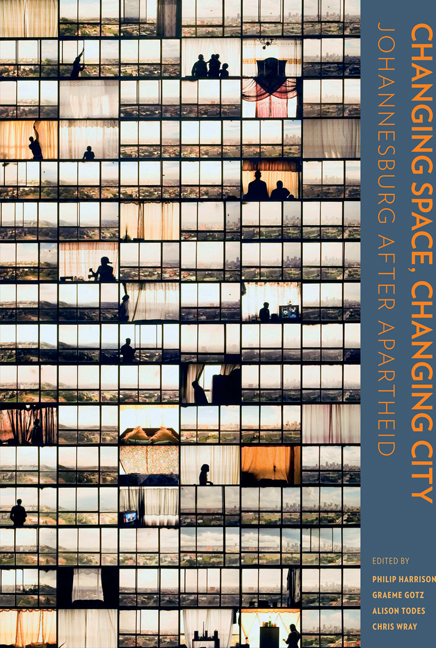Book contents
- Frontmatter
- Contents
- Preface
- Cartography
- 1 Materialities, subjectivities and spatial transformation in Johannesburg
- Section A The macro trends
- Section B Area-based transformations
- 12 Between fixity and flux: Grappling with transience and permanence in the inner city
- 13 Are Johannesburg's peri-central neighbourhoods irremediably ‘fluid’? Local leadership and community building in Yeoville and Bertrams
- 14 The wrong side of the mining belt? Spatial transformations and identities in Johannesburg's southern suburbs
- 15 Soweto: A study in socio-spatial differentiation
- 16 Kliptown: Resilience and despair in the face of a hundred years of planning
- 17 Alexandra
- 18 Sandton Central, 1969–2013: From open veld to new CBD?
- 19 In the forest of transformation: Johannesburg's northern suburbs
- 20 The north-western edge
- 21 The 2010 World Cup and its legacy in the Ellis Park Precinct: Perceptions of local residents
- 22 Transformation through transportation: Some early impacts of Bus Rapid Transit in Orlando, Soweto
- Section C Spatial identities
- Contributors
- Photographic credits
- Acronyms
- List of plates
- List of figures
- List of tables
- Index
22 - Transformation through transportation: Some early impacts of Bus Rapid Transit in Orlando, Soweto
from Section B - Area-based transformations
Published online by Cambridge University Press: 20 April 2018
- Frontmatter
- Contents
- Preface
- Cartography
- 1 Materialities, subjectivities and spatial transformation in Johannesburg
- Section A The macro trends
- Section B Area-based transformations
- 12 Between fixity and flux: Grappling with transience and permanence in the inner city
- 13 Are Johannesburg's peri-central neighbourhoods irremediably ‘fluid’? Local leadership and community building in Yeoville and Bertrams
- 14 The wrong side of the mining belt? Spatial transformations and identities in Johannesburg's southern suburbs
- 15 Soweto: A study in socio-spatial differentiation
- 16 Kliptown: Resilience and despair in the face of a hundred years of planning
- 17 Alexandra
- 18 Sandton Central, 1969–2013: From open veld to new CBD?
- 19 In the forest of transformation: Johannesburg's northern suburbs
- 20 The north-western edge
- 21 The 2010 World Cup and its legacy in the Ellis Park Precinct: Perceptions of local residents
- 22 Transformation through transportation: Some early impacts of Bus Rapid Transit in Orlando, Soweto
- Section C Spatial identities
- Contributors
- Photographic credits
- Acronyms
- List of plates
- List of figures
- List of tables
- Index
Summary
In August 2009 Johannesburg became the first city in Africa to implement a full Bus Rapid Transit (BRT) system named Rea Vaya (or ‘we are going’). Largely based on the South American model, which includes exclusive bus lanes, enclosed bus stations and high service quality, the first 26 km-long trunk line connects eastern Soweto with the CBD, while feeder buses extend its reach into other parts of Soweto. Simultaneous with the construction of the bus corridor, the City of Johannesburg has been upgrading bus station precincts, including landscaping public spaces and redeveloping buildings (CoJ 2009).
Rea Vaya can thus be read as another instalment of the City of Johannesburg's efforts to transform Soweto through a combination of infrastructure and policy interventions (as described in more detail in Chapter 15). But Rea Vaya is also more than this: through the incremental roll-out of further bus corridors across the city, the intention is to provide a network of metropolitan public transport that ‘improve[s] access and reduce[s] travelling time for residents to employment, education, recreation and markets’ (CoJ 2010: 241). The BRT is intended both as a sustainable transport option, capable of attracting car users and reducing congestion, and as an affordable option for low-income users. This dual mandate makes BRT a potentially important tool in the transformation of space in post-apartheid Johannesburg.
In this chapter we ask how successful BRT has been in achieving its second mandate, namely leveraging economic advancement for the poor. If BRT is to be instrumental in achieving social objectives in Johannesburg in years to come, the question is worth asking even at this early stage. The success of the Rea Vaya experiment is, however, also relevant in the context of national policy, as BRT has become an important element of the South African government's efforts to transform cities through spatial integration and provide ‘equitable basic access for all citizens’ (DoT 2007: 3). BRT systems are operational or under construction in at least four other South African metropolitan areas. Early lessons from the Rea Vaya experience could be valuable in assessing and perhaps adjusting the trajectories of these developments.
By many measures Rea Vaya can be considered a success: passenger numbers have steadily increased, new services have gradually been added and the taxi industry seems to be co-operating and participating in the transformation of public transport.
- Type
- Chapter
- Information
- Changing Space, Changing CityJohannesburg after apartheid, pp. 443 - 453Publisher: Wits University PressPrint publication year: 2014

